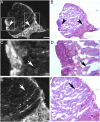Surgery with molecular fluorescence imaging using activatable cell-penetrating peptides decreases residual cancer and improves survival
- PMID: 20160097
- PMCID: PMC2840114
- DOI: 10.1073/pnas.0910261107
Surgery with molecular fluorescence imaging using activatable cell-penetrating peptides decreases residual cancer and improves survival
Abstract
The completeness of tumor removal during surgery is dependent on the surgeon's ability to differentiate tumor from normal tissue using subjective criteria that are not easily quantifiable. A way to objectively assess tumor margins during surgery in patients would be of great value. We have developed a method to visualize tumors during surgery using activatable cell-penetrating peptides (ACPPs), in which the fluorescently labeled, polycationic cell-penetrating peptide (CPP) is coupled via a cleavable linker to a neutralizing peptide. Upon exposure to proteases characteristic of tumor tissue, the linker is cleaved, dissociating the inhibitory peptide and allowing the CPP to bind to and enter tumor cells. In mice, xenografts stably transfected with green fluorescent protein show colocalization with the Cy5-labeled ACPPs. In the same mouse models, Cy5-labeled free ACPPs and ACPPs conjugated to dendrimers (ACPPDs) delineate the margin between tumor and adjacent tissue, resulting in improved precision of tumor resection. Surgery guided by ACPPD resulted in fewer residual cancer cells left in the animal after surgery as measured by Alu PCR. A single injection of ACPPD dually labeled with Cy5 and gadolinium chelates enabled preoperative whole-body tumor detection by MRI, intraoperative guidance by real-time fluorescence, intraoperative histological analysis of margin status by fluorescence, and postoperative MRI tumor quantification. Animals whose tumors were resected with ACPPD guidance had better long-term tumor-free survival and overall survival than animals whose tumors were resected with traditional bright-field illumination only.
Conflict of interest statement
Conflict of interest statement: Q.T.N., E.S.O., T.A.A., T.J., and R.Y.T. have signed a scientific advisory agreement with a company founded to develop the technology described in this article.
Figures






Similar articles
-
Activatable cell penetrating peptides linked to nanoparticles as dual probes for in vivo fluorescence and MR imaging of proteases.Proc Natl Acad Sci U S A. 2010 Mar 2;107(9):4311-6. doi: 10.1073/pnas.0910283107. Epub 2010 Feb 16. Proc Natl Acad Sci U S A. 2010. PMID: 20160077 Free PMC article.
-
Tumor Detection at 3 Tesla with an Activatable Cell Penetrating Peptide Dendrimer (ACPPD-Gd), a T1 Magnetic Resonance (MR) Molecular Imaging Agent.PLoS One. 2015 Sep 3;10(9):e0137104. doi: 10.1371/journal.pone.0137104. eCollection 2015. PLoS One. 2015. PMID: 26336058 Free PMC article.
-
Systemic in vivo distribution of activatable cell penetrating peptides is superior to that of cell penetrating peptides.Integr Biol (Camb). 2009 Jun;1(5-6):371-81. doi: 10.1039/b904878b. Epub 2009 May 11. Integr Biol (Camb). 2009. PMID: 20023744 Free PMC article.
-
Intraoperative Imaging Techniques to Support Complete Tumor Resection in Partial Nephrectomy.Eur Urol Focus. 2018 Dec;4(6):960-968. doi: 10.1016/j.euf.2017.04.008. Epub 2017 May 12. Eur Urol Focus. 2018. PMID: 28753888 Review.
-
Fluorescence-Guided Surgery.Front Oncol. 2017 Dec 22;7:314. doi: 10.3389/fonc.2017.00314. eCollection 2017. Front Oncol. 2017. PMID: 29312886 Free PMC article. Review.
Cited by
-
Tumor margin detection using quantitative NIRF molecular imaging targeting EpCAM validated by far red gene reporter iRFP.Mol Imaging Biol. 2013 Oct;15(5):560-8. doi: 10.1007/s11307-013-0637-8. Mol Imaging Biol. 2013. PMID: 23619897
-
Profluorogenic reductase substrate for rapid, selective, and sensitive visualization and detection of human cancer cells that overexpress NQO1.J Am Chem Soc. 2013 Jan 9;135(1):309-14. doi: 10.1021/ja309346f. Epub 2012 Dec 27. J Am Chem Soc. 2013. PMID: 23198810 Free PMC article.
-
Assessing breast cancer margins ex vivo using aqueous quantum-dot-molecular probes.Int J Surg Oncol. 2012;2012:861257. doi: 10.1155/2012/861257. Epub 2012 Dec 24. Int J Surg Oncol. 2012. PMID: 23320158 Free PMC article.
-
Organelle-Partitioned Sugar-Rhodamine Diad for In Vivo Tumor Imaging.ACS Omega. 2020 Jul 23;5(30):19014-19019. doi: 10.1021/acsomega.0c02323. eCollection 2020 Aug 4. ACS Omega. 2020. PMID: 32775903 Free PMC article.
-
An integrated widefield imaging and spectroscopy system for contrast-enhanced, image-guided resection of tumors.IEEE Trans Biomed Eng. 2015 May;62(5):1416-24. doi: 10.1109/TBME.2015.2389626. Epub 2015 Jan 9. IEEE Trans Biomed Eng. 2015. PMID: 25585410 Free PMC article.
References
-
- Ries LAG, et al. Bethesda, MD: National Cancer Institute; 2008. SEER Cancer Statistics Review, 1975–2005, http://seer.cancer.gov/csr/1975-2005/, based on November 2007 SEER data submission, posted to the SEER web site.
-
- Pattern of Care Studies/Quality of Care Studies . Bethesda, MD: National Cancer Institute,; 2008. SEER Cancer Statistics Review, 1975–2005. http://seer.cancer.gov/csr/1975_2005/, based on November 2007 SEER data submission, posted to the SEER web site.
-
- Singletary SE. Surgical margins in patients with early-stage breast cancer treated with breast conservation therapy. Am J Surg. 2002;184:383–393. - PubMed
-
- Meric F, et al. Positive surgical margins and ipsilateral breast tumor recurrence predict disease-specific survival after breast-conserving therapy. Cancer. 2003;97:926–933. - PubMed
Publication types
MeSH terms
Substances
Grants and funding
LinkOut - more resources
Full Text Sources
Other Literature Sources
Molecular Biology Databases

